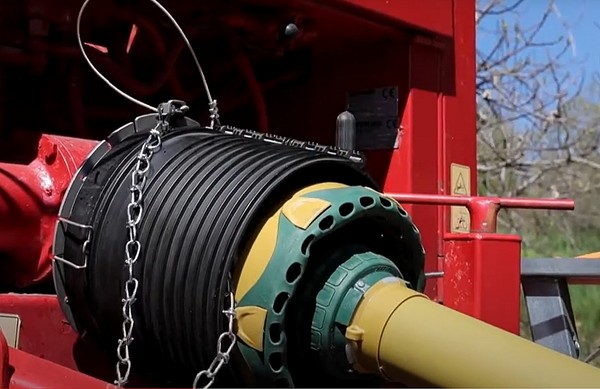
PTO shaft guards: there is still work to be done
Hits, cuts, scrapes, mishandling. Heat, cold, ice, acids, solar radiation. All of these elements contribute in the (quick) degradation of the PTO shaft guard components. For this reason, the manufacturers' efforts to improve the product as well as the users' diligence in its maintenance must remain at the highest level
The agricultural sector has long been competing with the construction industry for the sad record of severe and fatal accidents in the workplace. This issue has recently come to the forefront of national news several times with unanimous consensus regarding its seriousness and the consequent absolute urgency (widely recognized even at the highest levels of national governance) to implement effective and lasting actions to contain the problem and improve the situation.
Statistics prove that after tractor overturning, accidental contact with the Cardan shaft that has not been adequately protected and secured has always been the second cause of severe and, unfortunately, fatal accidents in agriculture. INAIL data reveal that only 0.7% of reported accidents involve the PTO shaft, yet unfortunately, these events almost always result in severe injuries (often with complete amputation of limbs and/or profoundly serious impairments and consequent permanent disability) and even in 8-12 fatal accidents per year.
To contain the risk, this device must therefore be isolated entirely with protection that prevents any unintentional contact (especially when the shaft is rotating). This protection is usually made up of various elements (essential: caps and tubes) connected together and fixed to the Cardan shaft with appropriate sliding bearings.
Limits of protection
All major manufacturers currently provide plastic protections that still reveal several criticalities. This is due to their intrinsic strength (i.e., mechanical resistance to blows, cuts, scratches, incorrect handling of the tractor-operator complex, etc.) and their durability. Apart from unforeseen events, the usual environmental temperature ranges, solar radiation, and some chemically aggressive substances commonly present on the farm (mineral and organic fertilizers, livestock manure, phytosanitary products, etc.) cause the material to deteriorate rather rapidly, resulting in browning, deformation, cracks, "flaking", etc.
The picture is improving. But it is still not enough...
A survey carried out about 25 years ago in Northern Italy on more than 600 Cardan shafts (and their guards) highlighted very dire use conditions. On that occasion, 22% of the guards were completely missing, 85% of the caps were severely damaged, and 50% of the telescopic tubes, while 85% of the decals were missing or illegible, and 90% of the decals were missing or illegible the retaining chains were absent.
Due to this situation, since the end of the '90s of the last century, the capillary action of control about the observance of the specific technical norms, accompanied by diligent campaigns of information and sensitization of the problem, has been progressively implemented. This action has been carried out by the bodies institutionally in charge, which is usually the Services of Prevention and Safety of the Workplaces of the Health Protection Agencies (the old local health authorities). Contextually, the entry into force and systematic application of the now well-known law 81/08 has brought about a further impulse to improve the situation.
In order to try and objectively quantify the data at issue, the survey already carried out in 1996 was recently renewed on about 300 Cardan shafts operating in the same areas.
The results show a moderately positive evolution of the general conditions of the protection of Cardan shafts, even if several important critical points persist. On this occasion, the primary protection elements were classified in six categories of decreasing suitability, from complete integrity to total absence, considering only the first two as positive (i.e., "perfect condition" and "minimal damage"), thus valid to ensure a sufficient level of operational safety. In this context, not even half of the caps (47%) and tubes (45%) are safe, while 70% of the retention chains are still missing, and almost 3/4 (72%) of the warning decals are in fact illegible, for various reasons.
Therefore, it is more critical than ever (and urgent) to improve the reliability and durability of the protections, in particular of some components that, over time, have shown the most severe problems.
Removable cones
In order to overcome the well-known difficulties of coupling the Cardan shaft with the motion sockets, some manufacturers have developed solutions that provide for the temporary removal of the cone (obviously with the shaft at a standstill), thus being able to act without constraints during the connection phase. The solution adopted proves to be all the more effective, the easier it is to execute, as well as reliable and long-lasting, and adaptable (or adjustable) according to the different types of Cardan shafts: traditional, wide-angle, single or double homokinetic, etc.
Walterscheid's new Premium Guard Cone (which deserved mention as a technical novelty at the EIMA 2016 edition) greatly simplifies what has been mentioned, and at the same time, makes the normal maintenance operations (the greasing) of the telescopic tubes and any overload protection devices less burdensome.
In addition to improved material quality, the new cone Guard can be opened, removed, and returned to its original position quickly and easily, thanks to its two-shell design. Depending on the shape of the Cardan shaft ends, the Premium Guard Cone is available in three different lengths: 180 mm ("S" size), 240 mm ("M"), and 300 mm ("L").
Centralized and rationalized greasing
The Cardan shaft is a mechanical device with several parts subject to friction, which in this case must be logically minimized for maximum power transmission efficiency. Hence, lubrication with grease is of paramount importance. Unfortunately, the greasing of the parts involved is not permanent; indeed, until some time ago, it was necessary to intervene in several points of the device and periodically with noticeably short intervals, even of only 8 hours. As a result, this maintenance operation was often neglected, if not completely ignored, with several negative consequences, which are easy to imagine.
Manufacturers have therefore endeavored to improve the situation by significantly lengthening the lubrication intervals and, more recently, by simplifying the distribution of grease to the various points of the Cardan shaft (including the guard) in need of lubrication.
By now, an interval of 50 hours between one intervention and the next is the standard, with some parts reaching 250 hours. Moreover, some components are now watertight and do not require further greasing other than that conducted during manufacture. A further significant simplification concerns reducing to a single point of grease delivery, which can easily reach all surfaces subject to lubrication, partly because they are all located on the same plane.
Retaining chain and shaped tubes
The two retention chains that usually equip the protection have always been among the components with the most critical issues, both because of their intrinsic weakness (especially of the eyelets fixing them to the guards) and because of the improper use they are often put to.
The chain is called "retention" because it is attached (at its opposite end) to one of the tractor's fixed parts or connected equipment. It must prevent the rotation of the guard in case of insufficient lubrication of the contact points with the rotating shaft. Conversely, it is often mistakenly used to hold the entire device in a suspended resting position, resulting in rapid degradation and subsequent inevitable breakage.
Spring Link" is a simple but effective device introduced by Bondioli and Pavesi to protect retention chains from damage. It consists of a ring that can be easily opened and closed employing a pair of wafer plates joined by a central screw, coupled with a spring hook sized to open to the loads provided by the dedicated standards (UNI EN ISO 5674 and ANSI/ASABE AD5674). If the length of the chain fitted with the Spring Link has not been correctly adjusted and the tension becomes excessive (for example, during certain "tight" maneuvers of the tractor-operator complex), the spring hook will stretch. The result will be the separation of the chain from the protection without damage, and the latter can then be reattached with a new spare hook (obviously identical to the previous one).
A significant evolution in the simplification of protection has recently been presented by Walterscheid, which now markets the ST model, whose two half-pipes have a section shaped like the Cardan shaft tubes. In this way, the relative rotation between the two elements can no longer be checked so that one of the two retention chains can be dispensed with. Furthermore, the chains may not be present in the version with the integral hood on the equipment side. The design of the new tubes has carefully taken into account the compatibility with the previous series already on the market to make immediate and easy replacement possible.
This is to the advantage of maintaining an elevated level of safety even for Cardan shafts already in use and needing new protection.
Bondioli e Pavesi has also addressed this problem. To limit the possibility that an incorrect chain attachment to a fixed point on the tractor could damage the protection, the "Single Chain" has been introduced.
This is a unique conformation of the telescopic tubes of the protection that makes the installation of one of the two retention chains unnecessary.
In detail, the inner tube is grooved and bound in a radial sense to the outer one by a band, positioned at about 100 mm from the end of the outer element (to allow for possible shaft shortening).
As a result, the two tubes of the protection are free to slide axially during normal shaft length variations but not rotate with respect to each other.
Consequently, a single chain, placed on the operating end (hence the name "Single Chain"), is enough to prevent rotation of the protection.
The rack
There are usually dozens of Cardan shafts in a farm, no matter how poorly structured; some are dedicated exclusively to the equipment with which they were sold, while others operate as "jokers", being mounted, when necessary, on machines that are not used continuously. However, it is good to provide for a certain number of spares in case of malfunction or breakage of those in use.
Contrary to what unfortunately sometimes happens, i.e., Cardan shafts lying on the ground in bulk in the corner of a shed, the proper storage and correct preservation of Cardan shafts must include using a rack of adequate strength. The rack must be placed in a sheltered place, where the individual specimens can be appropriately positioned for immediate identification and retrieval without requiring unnecessary and harmful physical effort.








